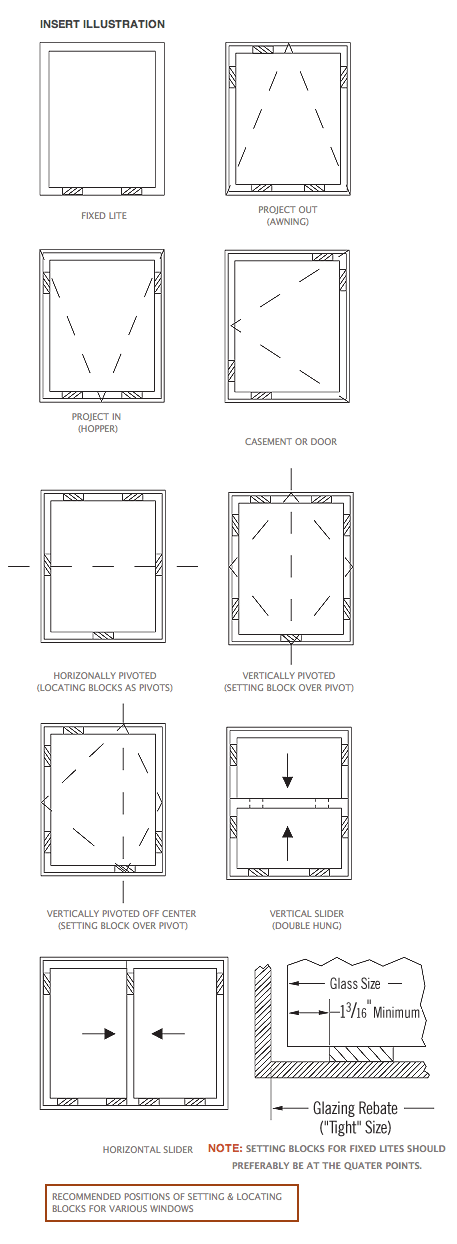GUIDELINES ON HOW TO INSTALL STEEL WINDOWS
These guidelines are meant to be general in nature. They are not intended to supersede or replace the installation instructions provided by the window manufacturer. Please contact the window manufacturer for its specific installation instructions or installation drawings.
CAUTION: Although these guidelines were written with regard for the safety of workers and bystanders, normal safety procedures, codes and regulations take precedence over these guidelines. Consult OSHA standards, local laws and building regulations when working above sidewalks, pathways, or other locations where falling debris may cause injury to people. Use appropriate personal protective equipment (safety glasses, gloves, back brace, etc.) during the window installation to prevent injury. Installer and end user should be aware of pinch points (hinges, latches, moveable vents and all joining parts) to avoid injury.
GETTING STARTED
Steel windows are designed to be installed directly into structural openings of wood, masonry, block, brick or structural steel. Typically, they are connected to the structural opening by either fastening directly through the window frame, or by anchor straps provided by the window manufacturer. Hot rolled windows are usually shipped unglazed, and therefore are installed in the structural opening before glazing. Cold rolled windows are usually shipped glazed, and are usually installed with anchor straps.
THE OPENING
Before installing a steel window, the installer must measure the opening for width and height and compare the dimensions of the opening to those of the window to make sure that a gap exists all around between the window and the opening. The opening should be measured at the top and bottom for the width measurement, and at both sides for the height measurement. This gap allows for construction tolerances, window fabrication tolerances, out of square variations in the opening, and thermal movement of the window. In general, a 1/4" design gap between the window and the opening all around is typical; however this gap should not be smaller than 1/8" and not greater than 1/2". In retrofit installations where multiple windows of the same size are being installed, the openings may be slightly different sizes and therefore the gaps will vary. Check the opening for squareness and adjust as necessary.
Fire rated window installations require the opening to be either made of non-combustible material, or protected with steel cladding.
Remove any objects that may obstruct the window from freely sliding into the opening.
PLACING THE WINDOW INTO THE OPENING
If the window will be installed by fastening directly through the frame, slide the window into the opening in its desired position, taking care not to force or pry it into place. If the installation requires anchor straps, attach the straps to the window frame at the locations specified by the window manufacturer before the window is placed into the opening.
Shim the window on all sides in the opening, making sure it is level and plumb. On installations using anchor straps, the anchor straps should protrude towards the interior.
FASTENING THE WINDOW
Once the window is level and plumb, 1/4" fasteners are used to anchor the window into the opening. The fasteners need to be suitable for the type of material the structural opening is made of. If fastening through the frame, holes will be provided for the fasteners in the window frame by the manufacturer. If using anchor straps, drill a hole in the strap at the desired location for the anchor fastener. All fasteners at the sill should be sealed with applied sealant or a sealing washer.
SEALING THE EXTERIOR PERIMETER GAP
Seal the exterior gap between the window and the structural opening with a sealant that is compatible with the window and opening material, the gap size and configuration, the weather exposure, and the expected movement of the window. Follow the recommended installation instructions of the sealant manufacturer. Gaps of 1/8" can usually be filled with sealant only, however gaps over 3/16" usually require a backing material such as backer rod to support the perimeter seal. The depth of the sealant in the joint gap should be 1/4" for non-porous materials, and 3/8" if porous materials are present in the opening.GLAZING THE WINDOW WITH GLAZING BEADS
CAUTION! Wear personal protective equipment (safety glasses, gloves, etc,) when handling and installing glass.
Hot rolled steel windows will ship with the aluminum glazing beads installed and taped in place. It is important to remember that steel windows are custom made, and therefore similar parts are not always interchangeable. Remove the glazing beads one at a time, marking the locations they came from so they can go back in the same positions.
Clean the glazing rebate, making sure all dust, dirt and oil are removed. Apply glazing tape to the perimeter of the glazing rebate. Position the glazing tape down 1/8" from the edge of the section to leave room for the cap bead of sealant. The glazing tape should be compatible with the type of glass being used. Consult the window manufacturer for the size and type of glazing tape to use.
Determine the size and locations for the glass setting & locating blocks to center the glass in the opening. Place setting and locating blocks in the appropriate locations depending on the type of window (see illustration below).

Remove the protective tape from the glazing tape.
Insert the glass, centering it in the opening, and gently press it against the glazing tape.
Usually, the glazing beads are held in place by clips pre-attached to the window frame. Snap the glazing beads into the clips between the glass and the frame. Consult the window manufacturer for instructions about the sequence of installing glazing beads.
Install the rubber-glazing gasket between the glass and the glazing beads. It helps to use a mild soap or Windex© as a lubricant to install the rubber gasket.
Apply a cap bead of silicone sealant to the outside surface of the glass where it meets the frame.
GLAZING FIRE RATED WINDOWS
DANGER! The glass used in a fire rated window must be UL© certified and labeled to match the UL© rating of the window. Any other glass used in a fire rated window will void the fire rating of the window and will put the building occupants in danger of severe injury or death in the event of a fire. Consult the window manufacturer for specific details on the type of glass for which the window was designed.
Typically, the glazing beads in a fire rated window are made of steel and attached with screws. Fire rated windows usually ship with the glazing beads installed. Remove the glazing beads, marking the locations they came from so they can go back in the same locations.
Clean the glazing rebate, making sure all dust, dirt and oil are removed. Apply glazing tape to the perimeter of the glazing rebate. Position the glazing tape down 1/8" from the edge of the section to leave room for the cap bead of sealant. The glazing tape should be compatible with the type of glass being used. Consult the window manufacturer for the size and type of glazing tape to use.
Determine the size and locations for the glass setting & locating blocks to center the glass in the opening. Place setting and locating blocks in the appropriate locations depending on the type of window (see illustrations above).
Remove the protective tape from the glazing tape.
Insert the glass, centering it in the opening, and gently press it against the glazing tape.
Replace the glazing beads, attaching them with the screws removed previously.
Consult the window manufacturer for instructions about the sequence of installing glazing beads.
If required, install the rubber-glazing gasket between the glass and the glazing beads.
Apply a cap bead of silicone sealant to the outside surface of the glass where it meets the frame. A cap bead can also be applied to the inside surface of the glass where it meets the glazing bead.
AFTER THE WINDOW IS INSTALLED
If steel windows are properly installed and maintained, it is possible for them to last the life of the building. After the window is installed, verify that the window operates correctly. Handles, stays and catches should be checked for proper operation and should move freely. Operable vents must operate smoothly and close tightly. Rubber weather seals should not have any nicks, tears or cuts. Make any adjustments necessary or as recommended by the window manufacturer. Any scratches or digs in the paint finish should be repaired with touch up paint as recommended by the window manufacturer.
Check to make sure that any drain holes in the outer frame sill are clear and unobstructed to insure correct window weather performance.
Once the window operates satisfactorily, clean the window using a mild non-alkaline soap and warm water, applied with a sponge or soft cloth. Rinse with clear water.
1300 Sumner Avenue Cleveland, OH 44115-2851
216 - 241 - 7333 | swi@steelwindows.com
© The Steel Window Institute (2019) Contents are the property of the Steel Window Institute, its members or others who have licensed the information. All rights reserved.






